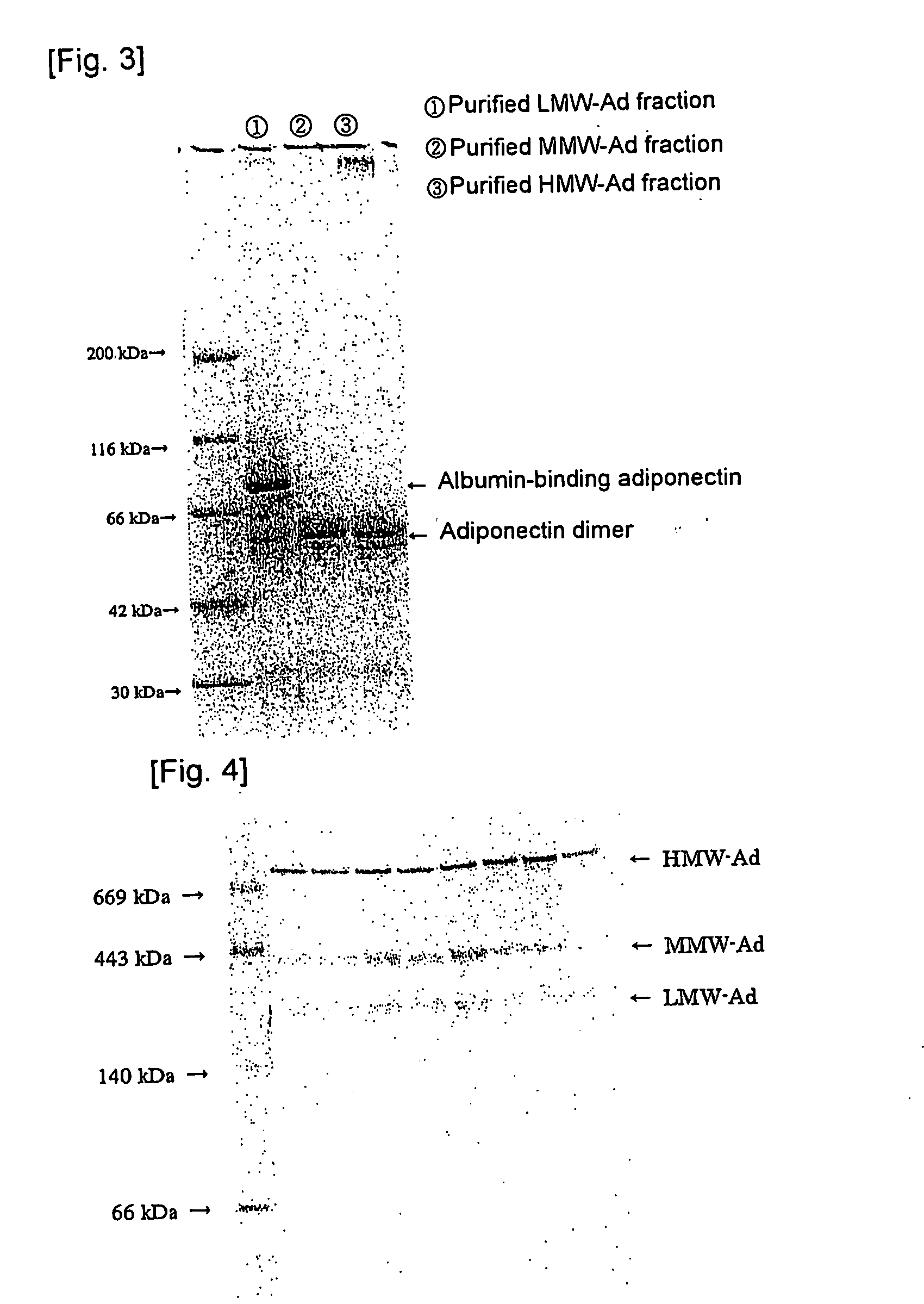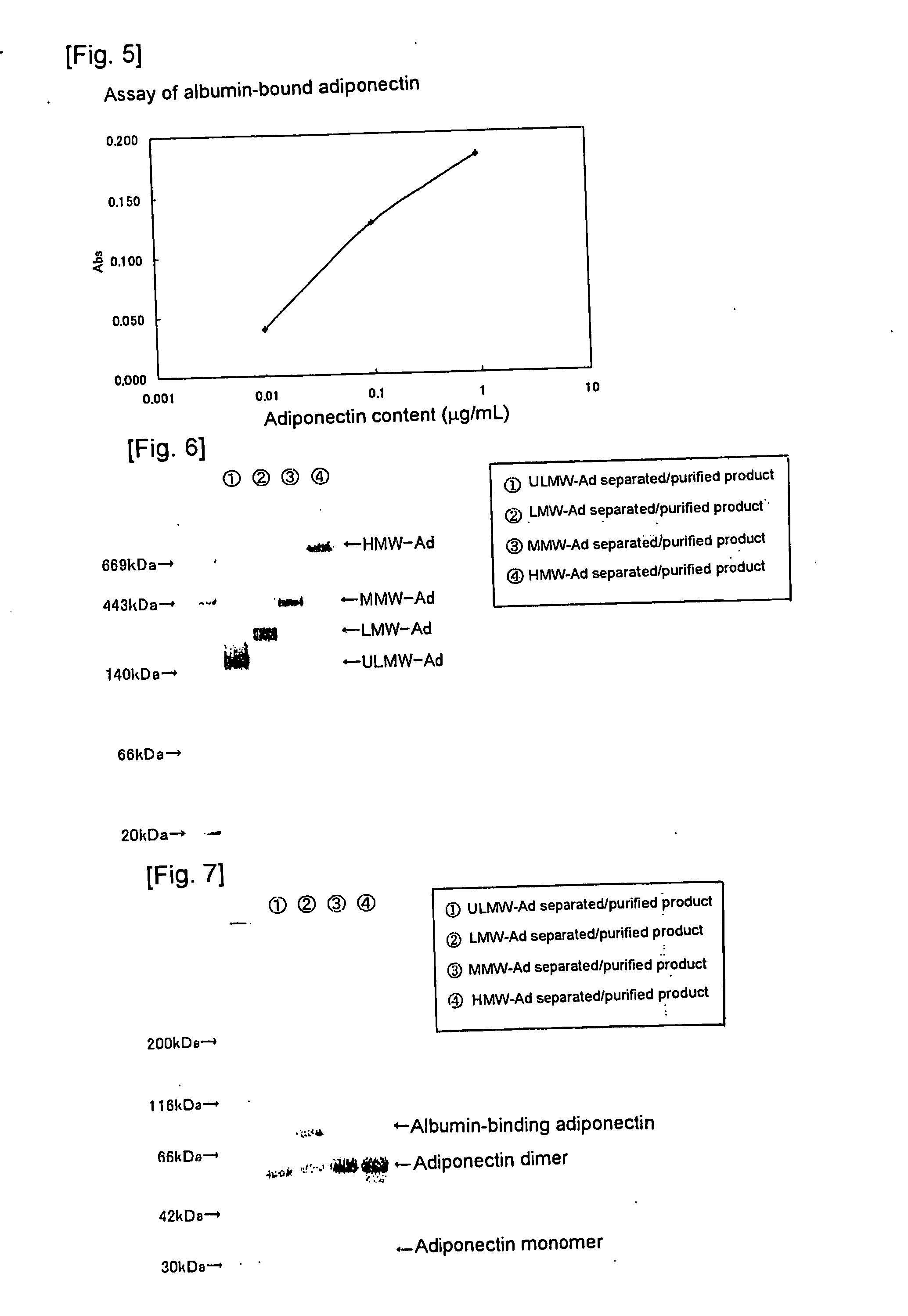Method of selectively assaying adiponectin multimers
a multi-mer, selective technology, applied in the direction of antibody medical ingredients, instruments, peptide sources, etc., can solve the problems of insufficient information about the relationship between the structure of adiponectin and physiological effects or diseases, inability to obtain sufficient information about the physiological effect of adiponectin, and inability to accurately reflect the behavior or action of adiponectin produced in an organism. to achieve the effect of accurate evaluation of the physiological effect of adipon
- Summary
- Abstract
- Description
- Claims
- Application Information
AI Technical Summary
Benefits of technology
Problems solved by technology
Method used
Image
Examples
referential example 1
Preparation of E. coli Recombinant Mouse Globular Adiponectin (rMgAd)
[0051] The globular domain sequence (corresponding to residues 104-247) of the mouse adiponectin gene sequence (NCBI accession #U37222) was inserted into BamHI and HindIII of a 6×His-tag-containing pQE30 vector, and then introduced into E. coli. Recombinant mouse globular adiponectin (rMgAd) expressed in E. coli was purified through the following process. Specifically, a soluble fraction of E. coli was added to Ni-NTA agarose (product of QIAGEN), and rMgAd was caused to bind for 16 hours at 4° C. rMgAd was serially eluted with imidazole, and a fraction containing adiponectin was collected and then dialyzed with PBS (pH 7.4) for three days. The protein content of the resultant rMgAd was determined by means of a Bio-Rad DC protein assay kit.
referential example 2
Production of Anti-rMgAd Antibody
[0052] rMgAd (50 μg) prepared in Referential Example 1 and the same amount of Freund's complete adjuvant were mixed together, and two rabbits were immunized with the mixture six times, at two-week intervals, to produce antiserum. Specific antibody (IgG) present in the antiserum was purified through a routine method by use of Protein A resin (anti-rMgAd antibody).
referential example 3
Purification of Adiponectin Multimer (mAd) Derived from Human Blood
[0053] The anti-rMgAd antibody (500 mg) prepared in Referential Example 2 was bound to CNBr-activated Sepharose 4B (Amersham Bioscience) (50 mL), to thereby prepare anti-rMgAd antibody-binding Sepharose 4B resin. Human serum (2.5 L) was added to the anti-rMgAd antibody-binding Sepharose 4B resin, and the resin was washed thoroughly with the antibody-binding resin wash liquid. The antibody-binding resin eluent was applied to obtain a human serum adiponectin fraction (mAd), and the antibody-binding resin neutralization liquid was added to the fraction for neutralization in an amount of 1 / 10 that of the fraction. Thereafter, the neutralized fraction was applied to Protein A resin, and a fraction containing components which are not adsorbed to the Protein A resin was collected as purified mAd. The adiponectin content was determined by means of a “human adiponectin ELISA kit” (Otsuka Pharmaceutical Co., Ltd.).
PUM
| Property | Measurement | Unit |
|---|---|---|
| molecular weight | aaaaa | aaaaa |
| molecular weight | aaaaa | aaaaa |
| molecular weight | aaaaa | aaaaa |
Abstract
Description
Claims
Application Information
 Login to View More
Login to View More - R&D
- Intellectual Property
- Life Sciences
- Materials
- Tech Scout
- Unparalleled Data Quality
- Higher Quality Content
- 60% Fewer Hallucinations
Browse by: Latest US Patents, China's latest patents, Technical Efficacy Thesaurus, Application Domain, Technology Topic, Popular Technical Reports.
© 2025 PatSnap. All rights reserved.Legal|Privacy policy|Modern Slavery Act Transparency Statement|Sitemap|About US| Contact US: help@patsnap.com



